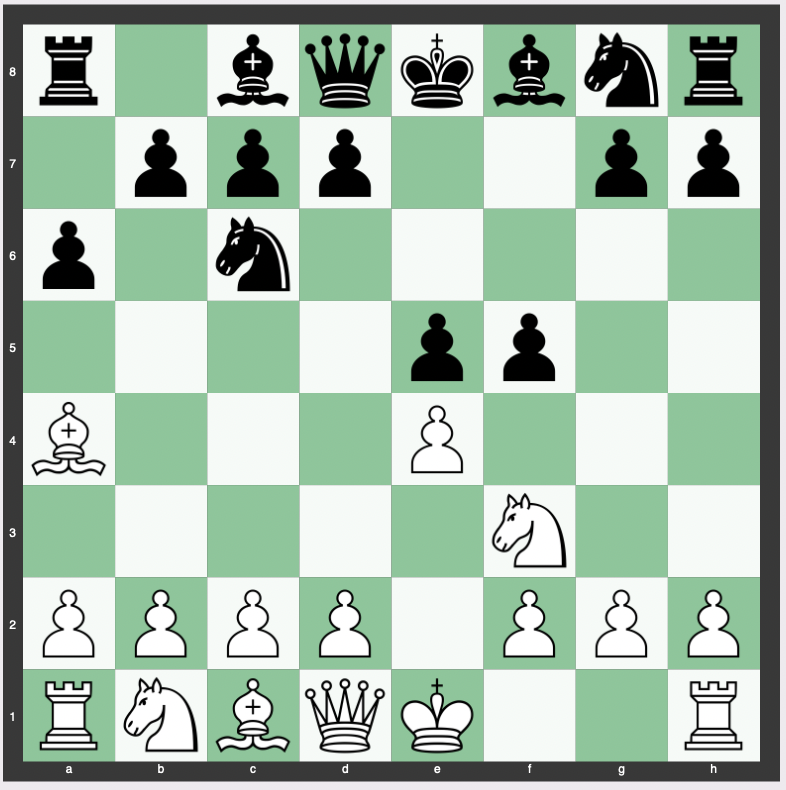The Schliemann Defense Deferred in the Ruy Lopez is the focus of this article.
The Schliemann Defense, named after the German merchant and amateur chess player, Heinrich Schliemann, features a distinctive move order and interesting variations.
Below we look into the nature of this opening, its history, and its applicability to various levels of chess mastery.
Move Order of the Schliemann Defense Deferred
Understanding the move order in the Schliemann Defense Deferred is crucial for fully grasping its mechanics and strategy.
The opening sequence typically unfolds as follows: 1.e4 e5 2.Nf3 Nc6 3.Bb5 a6 4.Ba4 f5.

This aggressive and assertive move order defines the character of the Schliemann Defense.
Theory, Strategy and Purpose of the Schliemann Defense Deferred
The underlying theory of the Schliemann Defense Deferred is grounded in the idea of wresting control of the center from the opponent early in the game.
By deploying 4…f5, Black seeks to challenge White’s control of the e4 square while also preparing to develop the King’s bishop.
This bold strategy can catch an unsuspecting player off guard and disrupt their planned development.
Variations of the Schliemann Defense Deferred
The Schliemann Defense Deferred features several variations.
After Black’s 4…f5, White has several potential responses, including 5. Nc3, aiming to bolster the center and quickly develop another piece, or the daring 5. Bxc6, which sacrifices the bishop pair to disrupt Black’s pawn structure.
Other options include 5.d3 or 5.exf5, with each presenting unique pathways and responses that can cater to different styles of play.
History of the Schliemann Defense Deferred
Named after Heinrich Schliemann, the Schliemann Defense has a long history in the world of chess.
Schliemann was a German merchant and an avid chess player in the 19th century, and his aggressive approach to the game often startled his adversaries.
Despite its historical roots, the Deferred variation of the Schliemann Defense is a relatively modern invention.
Today, it enjoys periodic popularity in both amateur and professional circles, serving as a potent tool in the hands of daring players.
Is the Schliemann Defense Deferred Good for Beginners or Intermediates?
The Schliemann Defense Deferred is more suitable for intermediate players rather than absolute beginners.
Given its aggressive nature and the inherent risks that come with early pawn pushes, a certain level of experience and understanding of chess dynamics is required.
Beginners may find it challenging to navigate the potential complications that may arise from this opening.
How Often Is the Schliemann Defense Deferred Played at the Grandmaster Level?
At the grandmaster level, the Schliemann Defense Deferred is played with some frequency, but it’s not as commonly seen as some of the mainline defenses in the Ruy Lopez, such as the traditional variations of the Closed or Open defenses.
While it can offer surprise value in certain situations, grandmasters often favor openings with more solid, less risky structures.
However, this opening can occasionally make an appearance in high-stakes games, especially as a surprise weapon.
Conclusion
The Schliemann Defense Deferred in the Ruy Lopez is a bold and aggressive opening, promising dynamic play and rich positions.
Its distinctive move order, theoretical underpinnings, and interesting variations make it a continuing topic of discovery in Ruy Lopez opening theory.
Despite its complexity, which can pose challenges for beginners, intermediate players and grandmasters alike can harness its potential to disrupt traditional Ruy Lopez structures and introduce surprise into their games.


